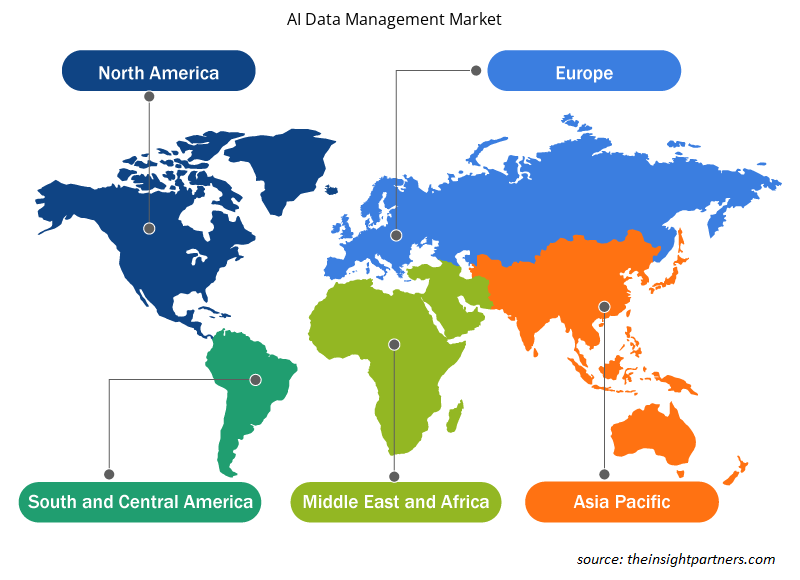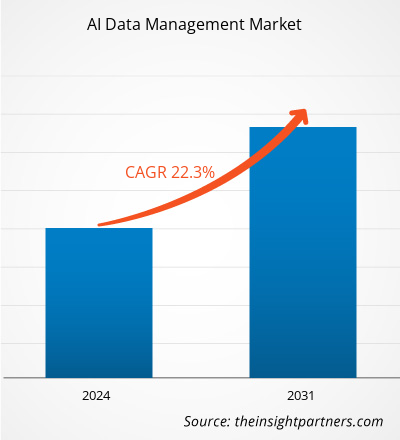预计到 2031 年,AI 数据管理市场规模将从 2023 年的 230.3 亿美元增至 1149.9 亿美元。预计 2023-2031 年市场复合 年增长率将达到22.3%。工业 4.0 的发展很可能仍是 AI 数据管理市场的关键趋势。
人工智能数据管理市场分析
报告包括考虑当前AI 数据管理市场趋势和影响市场增长的驱动因素的增长前景。AI、ML、NLP 、深度学习和云等先进技术的日益普及正在促进 AI 数据管理市场份额的扩大。在预测期内,对 AI 技术的投资增加以及BFSI和电子商务行业的扩张也有望推动 AI 数据管理市场的增长。AI 和 ML 在采用变革性数据管理解决方案方面的进步正在推动市场的发展。此外,全球消费者越来越多地采用个性化和自适应系统,这可能会为 AI 数据管理市场的增长带来增长机会。
AI数据管理市场概览
AI 数据管理是战略性地、有条不紊地使用 AI 技术来管理企业的数据资产。AI 数据管理软件涵盖了用于有效收集、组织、利用和存储数据的所有准则、程序和技术方法。该技术用于提高数据质量、分析和决策能力,从而增加了企业对 AI 数据管理的需求,并推动了全球 AI 数据管理市场的发展。
定制此报告以满足您的需求
您可以免费定制任何报告,包括本报告的部分内容、国家级分析、Excel 数据包,以及为初创企业和大学提供优惠和折扣
- 获取此报告的关键市场趋势。这个免费样品将包括数据分析,从市场趋势到估计和预测。
人工智能数据管理市场驱动因素和机遇
人工智能和基于机器学习的数据管理软件的进步推动了人工智能数据管理市场的增长
人工智能和机器学习技术的不断发展增加了消费者对有效管理组织数据的需求。人工智能的先进功能为企业提供了强大的工具,可以从收集的数据中生成详细的见解。将人工智能和机器学习集成到数据管理程序中被视为管理和解决与数据分析、处理和决策相关的复杂性的革命性因素。2023 年 5 月,国际商业机器公司推出了Watsonx平台,帮助企业管理和完全控制其数据。Watsonx平台与机器学习算法集成,允许组织收集和清理数据。人工智能和机器学习算法有助于自动化和优化数据管理操作。这些技术用于以超出人类能力的更快速度优化大型数据集,从而提高数据集成、分类和清理等数据管理任务的生产力。人工智能驱动的自动化数据管理可帮助企业显着降低出错的可能性,减少与手动流程相关的工作量,并确保数据驱动见解的可靠性和准确性。因此,基于人工智能和机器学习的数据管理软件的进步推动了市场的发展。
人工智能数据管理市场报告细分分析
有助于得出人工智能数据管理市场分析的关键部分是产品、部署、技术和垂直行业。
- 根据技术,AI数据管理市场分为机器学习、自然语言处理(NLP)、计算机视觉和情境感知计算。情境感知计算领域在2023年占据了更大的市场份额。
- 由于全球消费者的广泛采用,情境感知计算领域预计将在预测期内录得最高的复合年增长率。
- 情境感知技术是指系统根据情境动态调整其行为。这可让用户做出更相关、更细致的决策。情境感知计算使用算法根据各种情境输入(如时间、地点、用户行为和环境数据)解释和修改数据反应。情境感知计算考虑情境中数据的重要性,以改进分析和决策,进而改进数据的使用和解释。
- 然而,各行各业都对情境感知计算有着很高的需求,它利用情境数据来改进数据管理程序和结果,预计这将在预测期内推动市场增长。
人工智能数据管理市场份额(按地区)分析
AI数据管理市场报告的地理范围主要分为五个地区:北美、亚太、欧洲、中东和非洲、南美/南美和中美。
欧洲 AI 数据管理市场分为德国、法国、意大利、英国、俄罗斯和欧洲其他地区。由于数字化程度不断提高以及对 AL、ML、深度学习和 NLP 等先进技术的需求不断增加,预计德国市场将在预测期内扩大。例如,根据 ifo 研究所的数据,2023 年 8 月,13.3% 的德国公司已在其业务中部署了 AI 技术,9.2% 的公司计划在其业务中使用该技术来简化数据管理流程。基于 AI 的系统支持公司处理大量数据并通过自动数据分析做出快速决策。预计这些因素将在预测期内为欧洲 AI 数据管理市场增长创造丰厚的机会。
人工智能数据管理市场新闻和最新发展
通过收集一手和二手研究后的定性和定量数据来评估人工智能数据管理市场,其中包括重要的公司出版物、协会数据和数据库。以下是人工智能数据管理和策略市场的发展列表:
- 2023 年 11 月,亚马逊网络服务公司 (Amazon Web Services Inc) 在 Amazon DataZone 中推出了一项基于生成人工智能的创新功能的筛选。生成人工智能的功能通过改进业务数据目录来帮助增强数据发现、利用和理解。
- 2023 年 11 月,Databricks Inc 收购了 Arcion,以提供原生解决方案。Databricks Inc 使用 Arcion 的实时数据复制技术,以促进从不同数据库和 SaaS 应用程序中提取和无缝复制数据。
- 2023 年 9 月,Oracle 公司推出了 Fusion 数据智能平台,以协助使用 Oracle Fusion 云应用程序的客户。该平台代表了尖端数据、AI 平台和分析,可帮助用户将以数据为中心的洞察力与智能决策相结合,以实现卓越的业务。
- 2023 年 5 月,微软公司推出了 Microsoft Fabric,帮助组织简化数据和分析工具。Microsoft Fabric 帮助组织将众多解决方案与 Power BI、Azure Synapse Analytics 和 Azure Data Factory 等技术集成在一起,形成统一的产品。Microsoft Fabric 使数据和业务专家能够通过使用 AI 充分利用他们的数据,并简化与数据相关的工作流程。
- 2023 年 5 月,QlikTech International AB 收购了 Talend,以扩大其为现代企业管理、处理、分析和处理数据的能力。QlikTech International AB 与 Talend 之间的合作加强了许多领域,例如应用程序连接、数据转换、API 服务和质量保证。
人工智能数据管理市场区域洞察
Insight Partners 的分析师已详细解释了预测期内影响 AI 数据管理市场的区域趋势和因素。本节还讨论了北美、欧洲、亚太地区、中东和非洲以及南美和中美洲的 AI 数据管理市场细分和地理位置。

- 获取 AI 数据管理市场的区域特定数据
人工智能数据管理市场报告范围
| 报告属性 | 细节 |
|---|---|
| 2023 年的市场规模 | 230.3亿美元 |
| 2031 年市场规模 | 1149.9亿美元 |
| 全球复合年增长率(2023 - 2031) | 22.3% |
| 史料 | 2021-2022 |
| 预测期 | 2024-2031 |
| 涵盖的领域 | 通过奉献
|
| 覆盖地区和国家 | 北美
|
| 市场领导者和主要公司简介 |
|
人工智能数据管理市场参与者密度:了解其对业务动态的影响
由于消费者偏好的不断变化、技术进步以及对产品优势的认识不断提高等因素,最终用户需求不断增加,推动了人工智能数据管理市场快速增长。随着需求的增加,企业正在扩大其产品范围,进行创新以满足消费者需求,并利用新兴趋势,从而进一步推动市场增长。
市场参与者密度是指在特定市场或行业内运营的企业或公司的分布情况。它表明在给定市场空间中,相对于其规模或总市场价值,有多少竞争对手(市场参与者)存在。
在 AI 数据管理市场运营的主要公司有:
- 微软公司
- 亚马逊网络服务公司
- Alphabet 公司
- 甲骨文公司
- 国际商业机器公司
- Salesforce公司
免责声明:上面列出的公司没有按照任何特定顺序排列。

- 获取 AI 数据管理市场顶级关键参与者概览
人工智能数据管理市场报告覆盖范围和交付成果
“AI 数据管理市场规模和预测(2021-2031 年)”报告对以下领域进行了详细的市场分析:
- 范围内所有主要细分市场的全球、区域和国家层面的市场规模和预测
- 市场动态,如驱动因素、限制因素和关键机遇
- 未来主要趋势
- 详细的 PEST/波特五力分析和 SWOT 分析
- 全球和区域市场分析涵盖关键市场趋势、主要参与者、法规和最新市场发展
- 行业格局和竞争分析,涵盖市场集中度、热点图分析、知名参与者和最新发展
- 详细的公司简介
- 历史分析(2 年)、基准年、预测(7 年)及复合年增长率
- PEST和SWOT分析
- 市场规模、价值/数量 - 全球、区域、国家
- 行业和竞争格局
- Excel 数据集
近期报告
相关报告
客户评价
购买理由
- 明智的决策
- 了解市场动态
- 竞争分析
- 客户洞察
- 市场预测
- 风险规避
- 战略规划
- 投资论证
- 识别新兴市场
- 优化营销策略
- 提升运营效率
- 顺应监管趋势





















 获取免费样品 - 人工智能数据管理市场
获取免费样品 - 人工智能数据管理市场